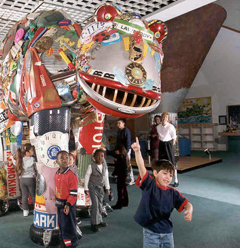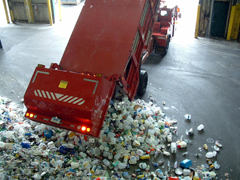From Trash to Cash – and Museums
Air Date: Week of May 9, 2008

Children play with Trashosauraus at the Children’s Garbage Museum. Credit: (Courtesy of the Connecticut Resources Recovery Authority.
Connecticut has facilities to turn trash into energy, but still has an overabundance of garbage, exporting 400 thousand tons of garbage every year. Host Bruce Gellerman pays a visit to the Trashosaurus at the Children’s Garbage Museum in Stratford, Connecticut. The museum’s goal is to educate kids about the five R’s – reduce, reuse, recycle, recover and re-think.
Transcript
GELLERMAN: It’s Living on Earth. I’m Bruce Gellerman.
[FRONT END LOADER ENGINE RUNNING; GEARS SHIFTING; PLASTIC CRUNCHES]
GELLERMAN: The driver shifts gears and his front end loader plows into a mountain of plastic bottles, jugs and jars.
[ENGINE HUMS; BEEP BEEP BEEP AS FRONT-END LOADER REVERSES]
GELLERMAN: …and then he backs up to charge ahead again…
[PLASTIC BOTTLES POP]
GELLERMAN: Pop…pop…pop. The giant wheels crush and crunch the plastic. It’s poetic, a strangely satisfying scene, perhaps even Shakespearean.
NONENMACHER: Refuse by any other name.
GELLERMAN: Paul Nonenmacher is director of public affairs at the Connecticut Resources Recovery Authority, and this recycling center in Stratford, Connecticut, is one of two facilities where the state turns trash into cash.
NONENMACHER: You know, there’s lots of euphemisms for it. You can be delicate and call it waste. But it’s garbage. And this is what we do. Garbage is our bread and butter, and we’d like to make a little less of it and be able to turn a little bit more of it into things that people can use every day.
GELLERMAN: That’s of course what happens at most recycling facilities, but Connecticut’s Resources Recovery Authority has also turned its recycling centers into museums: the Trash Museum in Hartford, and this one, the Children’s Garbage Museum in Stratford.
Nonenmacher says it all started about 15 years ago, when recycling began to catch on.

The Children's Garbage Museum in Connecticut. (Courtesy of the Connecticut Resources Recovery Authority.)
[CHILDREN TALKING IN MUSEUM LOBBY]
GELLERMAN: That’s right, Trashosaurus. The 24-foot long, 16-foot high T-rex. That’s T for Trash. The statue was built from stuff Connecticut residents dumped into the waste stream. For the past 13 years the statue has loomed large in the Garbage Museum, welcoming more than 50,000 visitors a year.
The day I visited, they were preparing Trashosaurus for a special day. Over the years he’s become something of a state symbol.
NONENMACHER: Our population in Connecticut is about 3.8 million people. Trashosaurus weighs one ton, so if you want to look at it in one particular way, each of us in Connecticut throws away one Trashosaurus every single year.
GELLERMAN: So this humongous statue made up of (laughing), let’s see, we got pieces of dolls and license plates and tennis rackets, and cell phone stuff and...
NONENMACHER: If anybody’s thrown it away, it’s represented here in Trashosaurus.
GELLERMAN: So Trashasorus is celebrating an anniversary.
NONENMACHER: He’s gonna be 13 years old. We’re having a party for him. In fact, he’s already wearing his birthday hat. He’s acting like a teenager before he becomes one, doing what ever he wants, and we’re gonna have birthday cake and candles and ice cream, and we’re gonna have a party for him. Trashosaurus is someone that just about everyone in Connecticut has met and always gets a kick out of seeing again.
MILCZANOWSKI: He’s awesome. (laughs)
[KIDS AND ADULTS TALKING IN MUSEUM LOBBY]
GELLERMAN: Michelle Milczanowski from Barkhamstead, Connecticut, brought her two children – John, five years old, and Patrick, two – to the Garbage Museum. The kids play ‘I Spy’ with T-rex. They get a list of items to find on Trashosauraus.

(Courtesy of the Connecticut Resources Recovery Authority.)
GELLERMAN: A flashlight. Boy. What do you think of Trashosaurus?
JOHN: Really...looks like a real dinosaur but it’s made out of trash.
GELLERMAN: So what do you think? Do you think this has a positive effect with kids, or is it just fun and games?
MILCZANOWSKI: No, definitely positive. My older son, the one you were just speaking with, is in kindergarten, and they have a recycle bin in his class, and he knows to recycle, and at home we do. We go to the dump in our town and we have the recycle bins, and they know that every Saturday we take our garbage, our recyclables, our cardboard, our plastic, our glass. So they’re already learning at a much younger age than we did. And this is very child-friendly
GELLERMAN: For Connecticut’s Resources Recovery Authority, trash is definitely not fun and games. The state has four trash-to-energy facilities that burn garbage to make electricity, says Paul Nonenmacher.
NONENMACHER: Garbage gives us, unfortunately, a never ending fuel supply. It’s hard to imagine our country running out of garbage.
GELLERMAN: One ton of garbage can produce the same amount of electricity as a barrel of oil, but unfortunately, the state has too much of a good thing.
NONENMACHER: Here in Connecticut we have to export about 400,000 tons of garbage every year because we don’t have room for it in our trash to energy plants. Our trash to energy plants are going full blast, 24/seven, 365, and we still need to send about 400,000 tons of garbage to landfills in Ohio, or New York or Pennsylvania or Massachusetts because we can’t take care of our own.
GELLERMAN: Wow. How expensive is that then?
NONENMACHER: Well, just to give you some idea, it costs us about 69 dollars to get rid of a ton of garbage. That’s what the towns pay us to bring it, and it’s up to us to get rid of it. Now if we have room in the plant, great. If we don’t have room, then we’ve got to put it on a truck and send it elsewhere, and that can cost us up to 90 dollars a ton.
GELLERMAN: So it literally pays Connecticut to recycle. There’s gold in them there are heaps of cell phones and electronic devices, and silver, and copper, and all the rest of the stuff the haulers collect and people recycle. For their efforts, Connecticut towns receive ten dollars a ton back from the state authority. But right now, Connecticut only recycles about 25 percent of the material people throw out, or about Trashasaurus’s hindquarter. The state wants to more than double that amount, to 58 percent, and has developed a plan to use a so-called single-stream system to make it easier to recycle. Soon residents won’t have to separate stuff – it’ll be done automatically at the recycling centers.
NONENMACHER: Even if we hit that goal, given increases in population, expansion of the economy, we’re still gonna have that capacity crunch in terms of disposal. So getting us to that 58 percent goal is just gonna keep us at status quo. So we need to do a lot better.

Children play with Trashosaurus. (Courtesy of the Connecticut Resources Recovery Authority.)jpg
[CHILDREN CHATTER IN BACKGROUND ]
SCIUTO: Garbologists, trashologist, call us whatever you want (laughing). We educate people in garbage. We talk trash and nobody gets into trouble.
GELLERMAN: And these days educator Audrey Sciuto talks trash to packed crowds.
GELLERMAN: You think like, you think you’re making a difference?
SCIUTO: Yeah, absolutely. We did an out-visit at Housatonic Community College – they had a health fair. And a woman came up, and here’s a little four year old, says he had gone to here, to the museum on a field trip with his class and saw his grandmother throwing a water bottle in the garbage, and told her, ‘grandma, that doesn’t go in the garbage, it goes in the recycling bin.’ So, we are making an impact. Little kids are going back. We’ll tell ‘em, you know, nag the adults, make sure they do it. You know, make sure they do it, you have to be sure they do it. And they do. So it’s good. It’s pretty cool.
GELLERMAN: Trashosaurus at 13 has really been hauling them in. If a teacher wants to book a class trip to the Children’s Garbage Museum in Stratford, Connecticut, the first opening is in mid-May. May, 2009, that is.
Living on Earth wants to hear from you!
Living on Earth
62 Calef Highway, Suite 212
Lee, NH 03861
Telephone: 617-287-4121
E-mail: comments@loe.org
Newsletter [Click here]
Donate to Living on Earth!
Living on Earth is an independent media program and relies entirely on contributions from listeners and institutions supporting public service. Please donate now to preserve an independent environmental voice.
NewsletterLiving on Earth offers a weekly delivery of the show's rundown to your mailbox. Sign up for our newsletter today!
 Sailors For The Sea: Be the change you want to sea.
Sailors For The Sea: Be the change you want to sea.
 The Grantham Foundation for the Protection of the Environment: Committed to protecting and improving the health of the global environment.
The Grantham Foundation for the Protection of the Environment: Committed to protecting and improving the health of the global environment.
 Contribute to Living on Earth and receive, as our gift to you, an archival print of one of Mark Seth Lender's extraordinary wildlife photographs. Follow the link to see Mark's current collection of photographs.
Contribute to Living on Earth and receive, as our gift to you, an archival print of one of Mark Seth Lender's extraordinary wildlife photographs. Follow the link to see Mark's current collection of photographs.
 Buy a signed copy of Mark Seth Lender's book Smeagull the Seagull & support Living on Earth
Buy a signed copy of Mark Seth Lender's book Smeagull the Seagull & support Living on Earth

